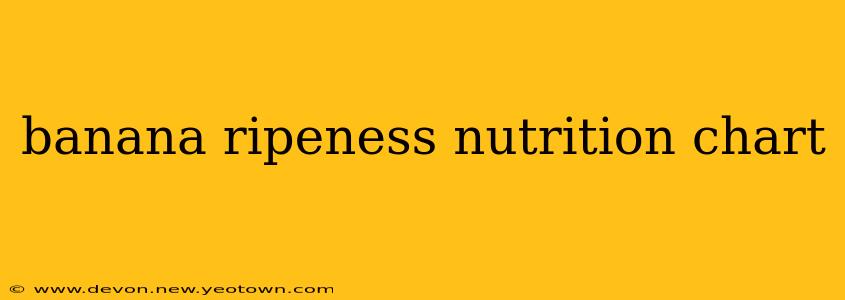Bananas, those ubiquitous yellow curves, are more than just a convenient snack. Their nutritional value fluctuates depending on their ripeness, offering a spectrum of benefits as they transition from green to brown. Understanding this shift helps you maximize the nutritional punch and flavor profile you get from your bananas. Let's embark on a journey through the stages of banana ripeness and explore their nutritional nuances.
What are the different stages of banana ripeness?
Bananas progress through several stages, each offering unique characteristics:
- Green Bananas: Firm to the touch, with a slightly tart flavor. They're packed with resistant starch, a type of fiber that resists digestion in the small intestine, feeding beneficial gut bacteria.
- Partially Green/Yellow Bananas: A transition stage, showcasing a blend of green and yellow. The starch content starts to convert to sugars, resulting in a slightly sweeter taste.
- Yellow Bananas: These are the classic bananas, ripe and ready to eat. They're soft to the touch and offer a balanced sweetness and creamy texture.
- Yellow with Brown Spots: These bananas have a sweeter taste and softer texture than fully yellow bananas. The brown spots indicate the breakdown of starch, further increasing sugar content and enhancing the overall sweetness.
- Brown Bananas (Overripe): These bananas are very soft, almost mushy, with significant brown spots or even completely brown skin. While they might seem past their prime, they are packed with antioxidants and are perfect for smoothies or baking.
Banana Ripeness Nutrition Chart: A Comparative Look
While a precise numerical chart is difficult due to variations in growing conditions and banana varieties, we can illustrate the general nutritional trends:
| Ripeness Stage | Starch Content | Sugar Content | Fiber Content | Antioxidant Levels | Texture | Taste |
|---|---|---|---|---|---|---|
| Green | High | Low | High | Lower | Firm | Tart |
| Partially Green/Yellow | Moderate | Moderate | Moderate | Moderate | Slightly Soft | Slightly Sweet |
| Yellow | Low | Moderate | Moderate | Moderate | Soft | Sweet |
| Yellow with Brown Spots | Low | High | Moderate | Higher | Very Soft | Very Sweet |
| Brown (Overripe) | Very Low | Very High | Moderate | Highest | Mushy | Very Sweet/Tangy |
How does banana ripeness affect nutritional value?
As bananas ripen, the starch content dramatically decreases, while sugar content increases significantly. This explains the increasing sweetness. The fiber content remains relatively consistent throughout the ripening process, although the type of fiber changes. Resistant starch is more abundant in green bananas, while soluble fiber becomes more prominent in ripe bananas. Antioxidant levels, notably those of dopamine, increase significantly as the banana ripens and browns.
What are the health benefits of different ripeness stages?
Green Bananas: Ideal for gut health due to their resistant starch content. They're also a good source of fiber and can help regulate blood sugar levels.
Ripe Yellow Bananas: A classic source of energy thanks to their natural sugars. They also provide potassium, vitamin B6, and vitamin C.
Overripe Bananas: A powerhouse of antioxidants. The increase in dopamine and other antioxidants contributes to immune support and overall health. Perfect for smoothies and baked goods.
How can I tell if a banana is ripe?
Gently squeeze the banana. A ripe banana will yield slightly to gentle pressure. Look for a bright yellow peel with minimal to moderate brown spots, depending on your preference for sweetness.
How can I store bananas to extend their shelf life?
Store bananas at room temperature to allow them to ripen naturally. If you need to slow down the ripening process, separate them from other fruits and vegetables and store them in the refrigerator, although this can affect their texture.
What are some creative ways to use overripe bananas?
Overripe bananas are perfect for:
- Smoothies: Their sweetness adds a delicious creaminess to any smoothie.
- Banana bread: The added sweetness is a perfect addition to banana bread recipes.
- Muffins: Similar to banana bread, overripe bananas enhance the sweetness and moisture of muffins.
- Ice cream: Blend them into your favorite ice cream recipe for a healthier treat.
Understanding the nuances of banana ripeness allows you to fully appreciate this versatile fruit, maximizing its nutritional benefits and culinary applications at every stage. So next time you pick up a bunch, take a moment to consider the ripening stage and the unique benefits it offers!

